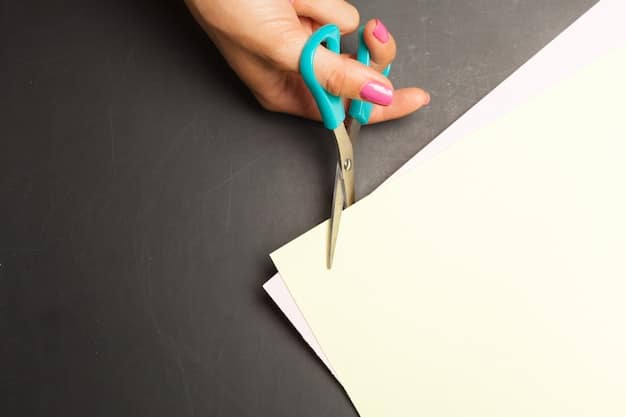Learn Kirigami: Intricate Japanese Paper Cutting Designs

Mastering the art of Japanese paper cutting, known as Kirigami, allows enthusiasts to create stunning, intricate three-dimensional designs from a single sheet of paper using simple tools, blending an accessible craft with profound cultural heritage.
Delve into the captivating world of Japanese Kirigami, a timeless art form that transcends mere paper folding to embrace the elegance of paper cutting. If you’re eager to learn the art of Japanese paper cutting (Kirigami): create intricate designs with simple tools, you’ve come to the right place. This guide will illuminate the origins, techniques, and the sheer joy of transforming a flat sheet into a three-dimensional masterpiece.
The Ancient Roots of Kirigami: A Cultural Journey
The art of Kirigami, often considered a cousin to origami, holds a rich history deeply intertwined with Japanese culture and spiritual practices. Unlike origami, which strictly prohibits cutting, Kirigami embraces the strategic use of scissors or knives to achieve its complex forms. Understanding its origins provides a deeper appreciation for this delicate craft.
While origami’s history is well-documented, Kirigami’s lineage is a bit more nuanced. Early forms of paper cutting for decorative and ceremonial purposes have been found across Asia, but Japan developed its distinct style. Initially, paper cutting was not merely an artistic endeavor but often served ritualistic functions, particularly in Shinto shrines.
From Ritual to Recreation: Kirigami’s Evolution
The earliest known applications of paper cutting in Japan included creating ‘gohei,’ zig-zag paper streamers used in Shinto rituals to purify offerings or areas. These early forms were simple yet foundational to the more complex designs that would emerge. As paper became more accessible, so did the craft of cutting it.
- Gohei: Symbolic paper strips used in Shinto purification rituals.
- Senbazuru: While primarily origami, the concept of repetitive, intricate paper work influenced Kirigami.
- Kamikiri: A traditional Japanese performance art involving speed cutting paper into figures.
Over centuries, Kirigami evolved from a purely ceremonial act to an intricate art form enjoyed by common people and artisans alike. The Edo period (1603-1868) saw a surge in various paper crafts, and Kirigami, with its ability to create detailed silhouettes and pop-up structures, found its niche. Its appeal lay in its transformative nature—taking a flat surface and bringing it to life with depth and dimension.
Today, Kirigami continues to captivate enthusiasts globally, bridging ancient traditions with modern artistic expression. It’s a testament to the ingenuity of Japanese artisans who found beauty and meaning in the simple act of cutting paper.
This historical context is vital, as it highlights that Kirigami is not just a craft; it’s a living tradition that carries significant cultural weight. Every cut, every fold, echoes centuries of artistic development and spiritual connection.
Essential Tools and Materials for Your Kirigami Journey
Embarking on your Kirigami adventure doesn’t require an extensive array of specialized equipment. One of the beauties of this art form lies in its simplicity. With just a few fundamental tools and the right paper, you’re well on your way to creating stunning designs. The key is quality over quantity, ensuring your tools are sharp and your paper is suitable for cutting and folding.
The choice of tools and materials significantly impacts the final outcome of your Kirigami project. Investing in good quality, even for basic items, will make the cutting process smoother and more enjoyable, especially when working on intricate patterns. Remember, precision is paramount in Kirigami, and good tools facilitate that precision.
Must-Have Tools for Beginners
Start with the basics before expanding your collection. A sharp pair of scissors and a craft knife are your primary instruments. Consider also a cutting mat to protect your work surface and a ruler for straight lines and accurate measurements.
- Small, Sharp Scissors: Precision is key. Embroidery or nail scissors work well for intricate details.
- Craft Knife (X-Acto or similar): Essential for precise cuts, especially internal ones and straight lines.
- Self-Healing Cutting Mat: Protects your workspace and knife blades.
- Metal Ruler: For precise straight cuts with your craft knife.
- Pencil and Eraser: For marking cutting lines lightly.
Beyond these, a bone folder can be incredibly useful for crisp folds, which are often integrated into Kirigami designs, particularly for pop-up structures. Tweezers can also aid in handling small, delicate pieces of paper without creasing or damaging them.
Choosing the Right Paper
Paper selection is crucial. Not all paper is created equal when it comes to Kirigami. You need paper that holds a fold well, can withstand delicate cuts without tearing, and isn’t too thick or too thin for your chosen design. Experimentation is often the best way to find your preferred type.

For beginners, standard origami paper can be a good starting point due to its consistent thickness and wide range of colors. However, as you advance, you might explore other options like heavier cardstock for more robust pop-ups or specialized craft papers for unique textures. The key is to avoid paper that easily tears or frays when cut.
A good paper choice enhances both the cutting experience and the aesthetic appeal of your finished piece. Consider the weight (GSM/lb) and the texture. Smooth, slightly stiff papers are generally easier to cut precisely than very thin or heavily textured ones. Remember, practice with different papers will help you understand their properties and how they react to cutting and folding.
Ultimately, the beauty of Kirigami lies in its accessibility. With just a few thoughtful purchases, you can begin to transform simple sheets of paper into works of art. Don’t feel pressured to buy everything at once; start small and expand your toolkit as your skills and interests grow.
Mastering Basic Kirigami Techniques: From Folds to Cuts
The essence of Kirigami lies in its harmonious blend of precise folding and accurate cutting. While the designs can appear incredibly complex, they often stem from a few fundamental techniques that, once mastered, open up a world of creative possibilities. Patience and precision are your best friends in this artistic endeavor.
Before diving into elaborate patterns, it’s essential to understand the core mechanics. Kirigami is not about haphazard cutting; every incision and every fold serves a purpose, contributing to the final three-dimensional form. This systematic approach is what differentiates Kirigami from simple paper snipping.
Fundamental Folding Techniques
Many Kirigami designs begin with a folded sheet of paper, similar to how snowflakes are cut. The type of fold dictates the symmetry and arrangement of your cuts. Clean, crisp folds are paramount for accurate cutting.
- Valley Fold: Folding the paper towards you, creating a ‘valley’ shape.
- Mountain Fold: Folding the paper away from you, creating a ‘mountain’ shape.
- Accordion Fold: Alternating valley and mountain folds, often used for pop-up elements.
- Symmetry Folds: Folding the paper in half, quarters, or eighths to create symmetrical designs when cut.
Practice making sharp creases using a bone folder or even your fingernail. A poorly executed fold can lead to misaligned cuts and a less refined final product. Start with simple folds, like folding a square in half diagonally or into quarters, and ensure the edges align perfectly.
Precision Cutting: The Heart of Kirigami
Once your paper is appropriately folded, the cutting begins. This is where your sharp tools come into play. The cleaner the cut, the more defined your design will be. Pay attention to the pressure you apply and the angle of your blade or scissors.
When using a craft knife, always cut on a self-healing mat. Use a metal ruler for straight lines to ensure they are perfectly precise. For curves and intricate internal cuts, carefully maneuver the paper rather than the knife itself, especially if using a fixed-blade craft knife. If using scissors, use the tip for fine details and the base for longer, straighter cuts.
Many Kirigami patterns involve cutting along pre-drawn lines. Always draw these lines lightly with a pencil so they can be easily erased after cutting. When cutting pop-up elements, remember that cuts are made to allow parts of the paper to be pushed forward or backward, creating the three-dimensional effect. Often, a combination of cuts and score lines (light creases that are not fully cut through) are used.
As you practice, you’ll develop a feel for the paper and your tools. Don’t be discouraged by initial imperfections. Kirigami, like any art form, requires practice and patience. Each failed attempt is a learning opportunity, refining your hand-eye coordination and understanding of how paper behaves under the blade.
Exploring Popular Kirigami Designs and Their Variations
Once you’ve grasped the basic techniques, the exciting world of Kirigami designs awaits. From simple pop-up cards to intricate decorative panels, the possibilities are vast. Many designs derive their complexity from repeating simple cuts and folds, creating a mesmerizing effect when unfolded or opened.
Understanding the categories of Kirigami can help you choose your next project and appreciate the diversity within this art form. Each category offers unique challenges and rewards, building upon the foundational skills you’ve developed.
Pop-Up Cards: Bringing Two Dimensions to Life
Perhaps the most widely recognized form of Kirigami, pop-up cards are a delightful way to add a three-dimensional surprise to a flat surface. These designs involve cutting and folding elements within a single sheet of cardstock, which then spring forward when the card is opened.
- Simple Tab Designs: Involve cutting two parallel lines and folding the tab between them forward.
- Box Folds: Create simple rectangular or square boxes that pop up.
- V-Folds: Create angled pop-ups, often used for figures or objects.
- Layered Pop-Ups: Combine multiple cuts and folds to create more complex, multi-tiered scenes.
Designing effective pop-up cards requires foresight. You need to visualize how the cuts and folds will interact when the paper is opened. Many tutorials provide templates, which are excellent for learning the mechanics before attempting your own designs. The magic lies in the sudden transformation from flat to volumetric.
Intricate Silhouettes and Geometric Patterns
Beyond pop-up cards, Kirigami also encompasses stunning flat designs, often characterized by intricate silhouettes or complex geometric patterns. These are achieved by folding paper multiple times and then making precise cuts along the edges, similar to paper snowflakes but with much greater detail and artistic intent.

These designs emphasize negative space and symmetry. Often, the paper is folded into many layers before cutting, meaning a single cut passes through multiple sheets, creating a repeating pattern when unfolded. This form of Kirigami often utilizes a craft knife for extremely fine details that scissors might struggle with.
Think of paper lace or highly detailed mandalas created through cutting. These projects are excellent for honing your precision cutting skills and developing an eye for symmetrical balance. They can be used for decorative purposes, such as wall art, window decorations, or even as stencils for other crafts.
Regardless of the design type, patience remains key. Rushing will lead to mistakes and torn paper. Take your time, enjoy the process, and marvel at the transformation of a simple sheet of paper into a work of art through the thoughtful application of cuts and folds.
Integrating Origami Folds into Kirigami Creations
While Kirigami distinguishes itself from origami by allowing cuts, the two art forms are by no means mutually exclusive. In fact, integrating traditional origami folds into your Kirigami projects can significantly expand your creative repertoire, adding structural integrity, dynamic movement, and fascinating complexity to your designs.
Think of it as leveraging the best of both worlds. Origami provides techniques for shaping and structuring paper without adhesive, while Kirigami offers the freedom of incision to create intricate details and pop-up mechanisms. This synergy allows for truly unique and innovative paper art.
Enhancing Structure and Dimension with Origami
Many Kirigami pop-up structures benefit immensely from precise origami bases or folds. For instance, a simple mountain or valley fold can form the foundation for a pop-up element, while more complex folds like the “tent fold” or “box fold” (which are common in origami for creating three-dimensional forms) can be integrated to provide robust support for pop-up figures or scenes.
Consider creating a pop-up bird. While the wings might be cut, the body of the bird could be formed using a basic origami bird base, giving it a natural, organic shape and allowing it to stand prominently from the card. This fusion adds a layer of sophistication that pure cutting alone might not achieve.
- Pre-folding: Creating base folds before cutting helps define the structure.
- Crease Patterns: Many Kirigami designs resemble origami crease patterns, guiding both folds and cuts.
- Structural Support: Origami folds can provide rigidity to delicate cut elements.
The strategic use of origami folds allows Kirigami artists to move beyond flat, two-dimensional cutouts and construct multi-layered, interactive pieces that literally unfold before the viewer’s eyes. It’s about understanding how paper behaves when folded and cut, and using that understanding to your creative advantage.
Creating Dynamic and Interactive Kirigami
When origami folds are incorporated thoughtfully, your Kirigami pieces can become more dynamic and interactive. Imagine a Kirigami card where opening it causes not only cut elements to pop up, but also makes them move or transform due to clever folding mechanisms.
For example, a series of parallel cuts (Kirigami) combined with an accordion fold (origami) can create a mesmerizing pull-tab mechanism that reveals hidden images or makes figures slide. Similarly, creating volumetric shapes through cuts and then adding origami-style pleats or crimps can add texture and depth that flat cutting cannot offer.
This integration encourages a deeper understanding of paper mechanics. It challenges the artist to think about the interplay of positive and negative space, tension, and movement. By embracing both folding and cutting, you unlock a broader spectrum of possibilities, allowing your Kirigami creations to truly come alive and engage the viewer in unexpected ways.
Troubleshooting Common Kirigami Challenges and Tips for Success
Even with careful planning and sharp tools, Kirigami can present challenges. Delicate paper, intricate patterns, and the need for precision mean that mistakes can happen. However, most common issues have straightforward solutions, and learning to troubleshoot them is part of mastering the art. Patience, persistence, and a willingness to learn from every cut are key.
Don’t be discouraged by initial setbacks. Every experienced Kirigami artist has faced torn paper, misaligned cuts, or designs that didn’t quite pop up as intended. These challenges are opportunities to refine your technique and understanding of the craft.
Dealing with Torn Paper and Imperfect Cuts
Tears often occur when applying too much pressure, using dull blades, or trying to cut paper that is too delicate for the chosen design. Imperfect cuts can result from unsteady hands or misjudging angles.
- Blade Sharpness: Ensure your craft knife blades are razor sharp. Replace them frequently, especially when working on detailed projects.
- Cutting Surface: Always use a self-healing cutting mat to provide a stable, non-slip surface.
- Steady Hand: Practice making long, continuous cuts. Use a ruler as a guide for straight lines, pressing firmly enough to prevent slipping.
- Paper Choice: If paper frequently tears, consider using a slightly heavier weight or a paper with a stronger fiber structure.
- Slow and Steady: Especially for intricate curves or small details, cut slowly and with deliberate movements. Multiple, light passes with the knife are better than one forceful cut.
For small tears, a tiny amount of white craft glue can sometimes repair the damage, but prevention is always better than cure. If a design is too intricate, consider simplifying it or scaling it up to make the cuts easier.
Pop-Ups That Don’t ‘Pop’ Effectively
One of the most frustrating issues in Kirigami is when a pop-up element doesn’t spring into action as expected. This usually stems from incorrect folding, insufficient scoring, or misaligned cuts.
Ensure your folds are crisp and well-defined. Use a bone folder to really press down on the creases. If a specific fold needs to be a mountain fold to push an element forward, make sure it is indeed a mountain fold. Sometimes, a light score line (a partial cut) where a fold should be can help guide the paper into popping correctly.
Check your cutting lines against the template. Even a slight deviation can affect the pop-up mechanism. For multi-layered pop-ups, ensure all components have adequate space to expand without snagging on other parts of the design. Sometimes, a small adjustment to a fold or an extra score can make all the difference.
Remember to test your pop-up as you go, especially with complex designs. Don’t wait until the very end to check if it works. This allows you to make corrections before the piece is fully assembled. With practice, you’ll develop an intuitive understanding of how cuts and folds interact to create the desired three-dimensional effect.
Kirigami as a Meditative Practice and Creative Outlet
Beyond its artistic appeal, Kirigami offers profound benefits as a meditative practice and a powerful creative outlet. The act of precisely cutting and folding paper can be deeply calming, fostering focus and mindfulness in our increasingly fast-paced world. Engaging with Kirigami is not just about the final product; it’s about the journey of creation itself.
In an age dominated by digital screens, the tangible nature of Kirigami provides a welcome respite. It connects us to traditional crafts and the simple joy of working with our hands. This hands-on engagement stimulates different parts of the brain and can lead to a sense of accomplishment and tranquility.
Mindfulness Through Repetition and Precision
The repetitive nature of some Kirigami patterns and the intense focus required for precise cuts can induce a meditative state. As you concentrate on the lines, angles, and the feel of the paper, external distractions fade away. This absorption in the task at hand mirrors the principles of mindfulness, anchoring you in the present moment.
- Focused Attention: Kirigami demands complete concentration, quieting the mind.
- Reduces Stress: The rhythmic, repetitive motions can be incredibly soothing.
- Boosts Patience: Intricate designs teach the value of taking one’s time.
This therapeutic aspect of Kirigami makes it more than just a hobby; it can be a tool for mental well-being. It provides a constructive way to channel energy, calm anxieties, and experience the satisfaction of creating something beautiful from scratch. The tactile experience of paper and the visual transformation of a flat sheet into a complex form contribute to this sense of calm and wonder.
Unleashing Creativity and Personal Expression
While many Kirigami designs follow established templates, the art form also provides ample room for personal expression. As you become more skilled, you can begin to modify existing patterns or even design your own unique creations. This journey from imitation to innovation is deeply rewarding.
Experiment with different paper types, colors, and textures to convey different moods. Challenge yourself to integrate unconventional elements or to tell a story through a pop-up scene. The flexibility of Kirigami allows you to infuse your personality into each piece, making it truly yours.
Furthermore, sharing your Kirigami creations, whether as cards, gifts, or decorative pieces, can be a source of pride and connection. The delight on someone’s face when they open a beautifully crafted pop-up card is a testament to the power of this art form to bring joy and wonder. Kirigami is a journey of continuous learning and boundless creative exploration, offering both meditative calm and explosive artistic freedom.
| Key Aspect | Brief Description |
|---|---|
| 📜 History | Ancient Japanese paper cutting, from Shinto rituals to modern art. |
| ✂️ Tools & Paper | Requires simple tools like sharp scissors, craft knives, and suitable paper. |
| 📐 Techniques | Combines precise folding and cutting to create 3D forms and intricate designs. |
| 🧘♂️ Benefits | Offers meditative practice, stress relief, and a creative outlet. |
Frequently Asked Questions About Kirigami
The primary distinction lies in cutting. Origami is strictly paper folding without any cuts or glue, creating shapes solely through manipulation. Kirigami, however, embraces both folding and cutting to achieve its designs, often resulting in intricate pop-up structures or detailed silhouettes that would be impossible with folding alone.
While various papers can be used, medium-weight paper (around 80-120 gsm) that holds a crisp fold and withstands precise cuts is generally preferred. Standard origami paper, cardstock for pop-ups, or good quality craft paper are excellent choices. Avoid paper that tears easily or is too thick to cut cleanly.
Kirigami can seem challenging due to its intricate results, but it’s very accessible for beginners. Starting with simple patterns and gradually moving to more complex ones is key. Patience, practice with basic folds and cuts, and using sharp tools will help beginners quickly develop the necessary skills and produce beautiful results.
You can start Kirigami with very simple tools like a pair of sharp small scissors and regular paper. However, a craft knife and a self-healing cutting mat are highly recommended for precision and to protect your surfaces, especially as you create more detailed or complex designs. They greatly enhance the cutting experience and the quality of the final piece.
Kirigami is versatile. Pop-up cards are a very popular application, adding a delightful surprise to greetings. Other uses include decorative wall art, intricate lanterns, book illustrations, storytelling elements in scrapbooks, architectural models, and even educational tools to teach geometry and spacial reasoning. Its artistic and functional possibilities are vast.
Conclusion
The journey into Kirigami is an enriching exploration of precision, creativity, and cultural heritage. From its ancient roots in Japanese ceremonial practices to its modern manifestation as a beloved art form, Kirigami offers a unique blend of meditative focus and artistic expression. By mastering simple tools and fundamental techniques of folding and cutting, anyone can transform a flat sheet of paper into intricate, three-dimensional designs that captivate and inspire. Embrace the patience required, celebrate each successful cut, and allow the subtle beauty of Kirigami to unfold in your hands. It’s more than just a craft; it’s a testament to the profound artistry found in simplicity.





